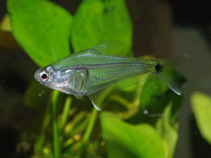| Family: |
Characidae (Characins; tetras), subfamily: Cheirodontinae |
| Max. size: |
3.1 cm SL (male/unsexed) |
| Environment: |
pelagic; freshwater |
| Distribution: |
South America: major river systems of the central and western portions of the Amazon basin including the Amazonas- Solimões, Purus, Madeira and Ucayali rivers. |
| Diagnosis: |
Dorsal soft rays (total): 9-10; Anal soft rays: 47-51. Protocheirodon pi can be distinguished by possessing four synapomorphies proposed for the Cheirodontinae by Malabarba (1998): presence of a pseudotympanum, a hiatus in the body wall musculature lateral to at least a portion of the anterior chamber of the swimbladder; absence of dark humeral spot; possession of pedunculate dentition; and presence of only a single row of regularly arranged premaxillary teeth. It differs from all species of the Cheirodontinae and indeed members of the Characiformes by the unique form of the swimbladder which has a smaller rotund anterior chamber and the posteriorly chamber elaborated into two vertically elongate, side by side, slightly inclined chambers. These modifications resulted to a unique overall pi (?)-shaped structure (Ref. 109753). |
| Biology: |
Found in marginal areas of rivers and streams, often over sandy substrates and in still backwaters (Ref. 109753). |
| IUCN Red List Status: |
Least Concern (LC); Date assessed: 30 October 2020 Ref. (130435)
|
| Threat to humans: |
harmless |
Source and more info: www.fishbase.org. For personal, classroom, and other internal use only. Not for publication.
